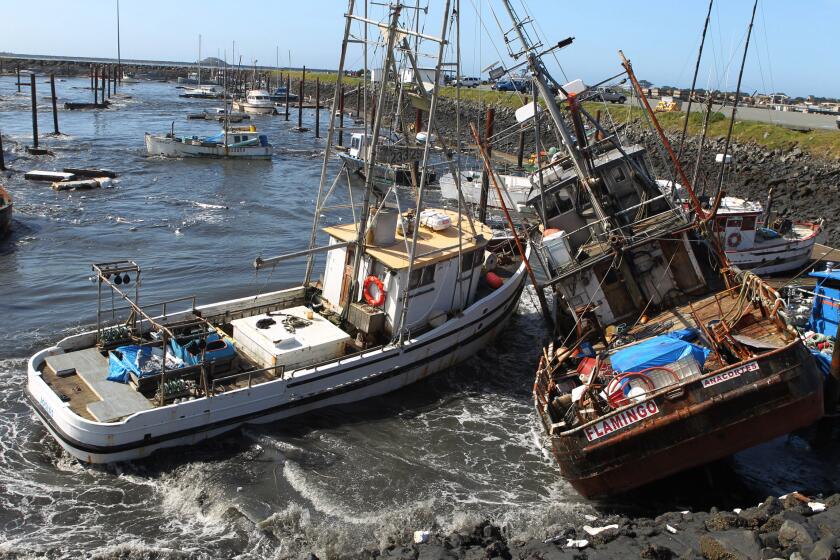Once-Bustling Liberty Port Ruined by Volcanic Ash
- Share via
OLONGAPO, Philippines — Until Saturday’s eruption of Mt. Pinatubo, the recently renovated 200-bed Olongapo General Hospital had a modern operating room, sophisticated laboratory, computerized blood bank and a dozen busy wards in a tree-shaded cluster of one-story bungalows.
“Now almost the entire hospital is devastated,” Dr. Arturo Mendoza, chief physician, said Tuesday amid the rubble. “The delivery and nursery complex, the pediatric ward, private wards, orthopedic ward, surgical ward, supply room, all gone.”
The 38-year-old doctor suddenly began to cry. “I’m so sad,” he said, as tears streamed down his face. “I can’t imagine how this thing has happened to us.”
Misery and hardship are everywhere in this once-bustling city of 330,000, now buried under eight inches of heavy volcanic ash. Long notorious as the raunchiest liberty port in the Pacific for American sailors at the neighboring Subic Bay Naval Base, Olongapo is now in ruins.
“Practically all government buildings are down,” said Mayor Richard Gordon. “We lost our high school, most of our elementary schools. The public markets, bus stations, all are down. Every other guy has lost his home. We have no power, no water, no schools for our children.”
He estimated damage in the city at $150 million. Across central Luzon, the astonishing weekend of thunderous volcanic eruptions, numerous earthquakes, a fierce typhoon and deadly mudslides destroyed thousands of buildings, buried rich farmland and caused an estimated 200,000 people to flee for their lives. The death toll rose to 146 people, Red Cross officials said, including 39 in Olongapo, the worst-hit major city.
Along Magsaysay Drive, the gaudy strip of nightclubs and massage parlors outside the American base, one in three buildings collapsed from the weight of wet sand and volcanic debris. Johnny O’s and the Old West, Playmates and Metallica, are down. So is the American Legion Post 4, a joint fire and police station, hotels and a casino.
“Everything is ruined,” said Daniel Pilapi, whose souvenir shop was destroyed. “I am ruined.”
Two Americans drank lukewarm beer outside the darkened Oak Barrel, one of the few of the city’s 315 bars to open Tuesday. But manager Emilou Elarmo worried that business may never recover. “If no more Americans, no more business,” she said.
Workers shoveled heavy ash off rooftops, heaving it onto giant mounds that made traffic on the ash-clogged streets that much worse. Throngs of dazed pedestrians dodged the flying sand and picked their way down streets rutted with huge bumps and deep puddles fed by sporadic downpours.
Relief efforts appeared basic at best. Eleven yellow firetrucks brought drinking water from Manila on a bone-jarring road lined with downed trees. Gas is rationed, and hundreds of people lined up at two open stations to fill plastic jugs with kerosene for cooking. Shovels quickly sold out, but food was available at inflated prices.
“Food prices have doubled,” said security guard Rusty Carpio. “Doubled! And it takes 2 1/2 hours on line. Olongapo is a city in crisis.”
Conditions were hardly better inside the crippled Navy base. Power and water were still off, and only emergency vehicles were being allowed on nearly impassable roads. “I don’t think anybody has a clear idea how long it’ll take to clean up the base and the facility,” said spokeswoman Betty Fielder.
Seven U.S. warships carried off 3,000 Air Force dependents in the third day of America’s largest peacetime evacuation. By the weekend, most of the 20,000 civilians on the base will have been taken to Cebu island on 17 ships, then flown back to the United States. Families are being told to expect to stay home at least two months.
Several active-duty officers, sailors and airmen said they have been told to expect redeployment from the Philippines in a reduction of military forces in coming weeks. There was no public announcement of the move, however, and Fielder said she was unaware of plans to evacuate troops as well as civilians.
But the rumors sent many Americans off base for a last look. Robert Weeks, a sailor with tattoos on both arms, carried a souvenir beer glass away from the ruins of the Sierra Bar, a relic of what he called “lots of lewd nights” there.
“Deep down, everybody knows this is the last time,” Weeks said sadly. “Lot of memories, man, lot of memories.”
Nearby, Air Force Sgt. Tony Hardy and his Filipina wife, Babylie, wandered the muddy streets hand in hand on their last night together. She is scheduled to be evacuated today while he stays behind in their first major separation in two years of marriage.
“We’re trying to find something to eat,” Hardy said. “And a shower if possible. We’ve been sleeping in the car because of the tremors.”
Mt. Pinatubo registered several minor eruptions and volcanic quakes Tuesday but was steadily calming after its violent eruptions last week. Manila’s ash-covered airport, closed since Saturday, is likely to reopen Thursday, officials said.
Olongapo’s ruin is all the worse because of the city’s progress in the last five years. The energetic 46-year-old mayor registered and regulated the 8,000 bar girls, banned female boxing and cockfights and made drivers of public “jeepneys” wear uniforms and color-coded their vehicles and routes to reduce traffic chaos.
Crime fell and pride grew as Gordon plastered the city with scores of boosterish slogans, from “Aim High Olongapo!” to “Don’t Be Lazy in Olongapo!” Signs on orange garbage trucks boasted that it was the “Cleanest City in the Philippines.” It was probably even true.
Now, while Gordon insists that “we can get back on our feet,” even he has doubts. “Sometimes I just want to bawl,” the mud-splattered mayor said after a day of viewing his devastated city. “I just can’t help it.”
More to Read
Sign up for Essential California
The most important California stories and recommendations in your inbox every morning.
You may occasionally receive promotional content from the Los Angeles Times.














